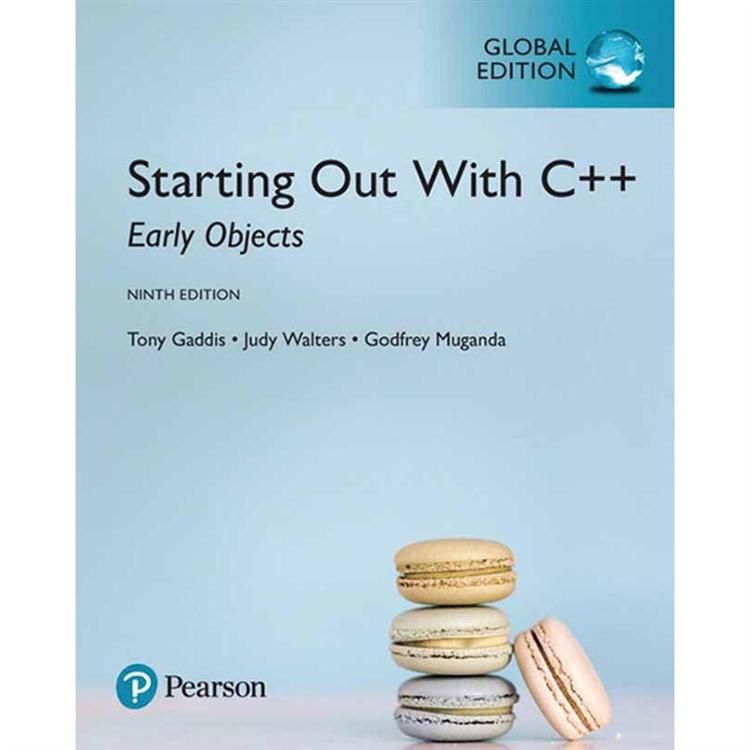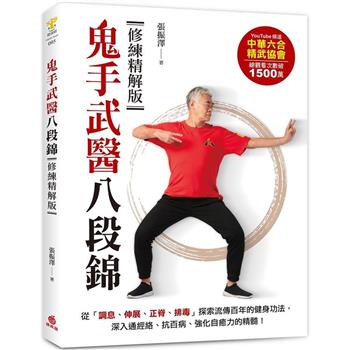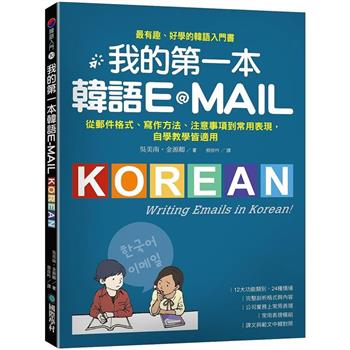| FindBook |
有 4 項符合
STARTING OUT WITH C++: EARLY OBJECTS 9/E (GE)�的圖書 |
 |
STARTING OUT WITH C++: EARLY OBJECTS 9/E (GE) 作者:GADDIS、WALTERS、MUGANDA 出版社:PE 出版日期:2019-05-23 語言:繁體書 |
| 圖書館借閱 |
| 國家圖書館 | 全國圖書書目資訊網 | 國立公共資訊圖書館 | 電子書服務平台 | MetaCat 跨館整合查詢 |
| 臺北市立圖書館 | 新北市立圖書館 | 基隆市公共圖書館 | 桃園市立圖書館 | 新竹縣公共圖書館 |
| 苗栗縣立圖書館 | 臺中市立圖書館 | 彰化縣公共圖書館 | 南投縣文化局 | 雲林縣公共圖書館 |
| 嘉義縣圖書館 | 臺南市立圖書館 | 高雄市立圖書館 | 屏東縣公共圖書館 | 宜蘭縣公共圖書館 |
| 花蓮縣文化局 | 臺東縣文化處 |
|
|
新版特色:
.C++11 topics have been added to several chapters to support the latest standard version of the C++ language.
.UPDATED! Updated material throughout the book reflects changes in technology and software development environments, improves clarity and incorporates best practices in teaching introductory programming. As a result, new graphics and new or redesigned figures have been added throughout the book where appropriate, and new or improved sample programs have been included in a number of chapters.
.Includes new sections on literals, random numbers, and enumerated data types, as well as improved material on designing classes.
.New Programming Challenge problems have been added to every chapter.
.UPDATED! Chapters have been redesigned to improve student learning. Chapter 5 (Looping) has been reorganized to give students more practice using the while loop before introducing do-while and for loops. The Chapter 6 (Functions) material on defining and calling functions has been reorganized to introduce function prototypes earlier and allow main to always be the first function in a file.
MyProgrammingLab® not included. Students, if MyProgrammingLab is a recommended/mandatory component of the course, please ask your instructor for the correct ISBN and course ID. MyProgrammingLab should only be purchased when required by an instructor. Instructors, contact your Pearson representative for more information.
MyProgrammingLabis an online learning system designed to engage students and improve results. MyProgrammingLab consists of a set of programming exercises correlated to the programming concepts in this book and improves the programming competence of beginning students who often struggle with the basic concepts of programming languages. For students, the system automatically detects errors in the logic and syntax of their code submissions and offers targeted hints that enable students to figure out what went wrong. For instructors, a comprehensive gradebook tracks correct and incorrect answers and stores the code inputted by students for review.
.Interactive Practice provides first-hand programming experience in an interactive online environment.
.Approximately two-hundred small practice exercises cover topics such as variables, calculations, decision statements, loops, procedures, arrays, and more.
.Error Messages for Incorrect Answers give students immediate personalized feedback. The error messages include both the feedback from the compiler and plain English interpretations of likely causes for the incorrect answer.
.Step-by-step VideoNote Tutorials enhance the programming concepts presented in your Pearson textbook by allowing students to view the entire problem-solving process outside of the classroom—when they need help the most.
.Pearson eText gives students access to their textbook anytime, anywhere. In addition to note taking, highlighting, and bookmarking, the eText offers interactive and sharing features. Rich media options let students watch lecture and example videos as they read or do their homework. Instructors can share their comments or highlights, and students can add their own, creating a tight community of learners in your class. The Pearson eText companion app allows existing subscribers to access their titles on an iPad or Android tablet for either online or offline viewing.
.Dynamic grading and assessment provide auto-grading of student assignments, saving you time and offering students immediate learning opportunities:
。A dynamic roster tracks their performance and maintains a record of submissions.
。The color-coded gradebook gives you a quick glance of your classes' progress. Easily drill down to receive information on a single student's performance or a specific problem. Gradebook results can be exported to Excel to use with your LMS.
圖書特色與優點:
This title is a Pearson Global Edition. The Editorial team at Pearson has worked closely with educators around the world to include content which is especially relevant to students outside the United States.
About the Book
.NEW! C++11 topics have been added to several chapters to support the latest standard version of the C++ language.
.UPDATED! Updated material throughout the book reflects changes in technology and software development environments, improves clarity and incorporates best practices in teaching introductory programming. As a result, new graphics and new or redesigned figures have been added throughout the book where appropriate, and new or improved sample programs have been included in a number of chapters.
.NEW! Includes new sections on literals, random numbers, and enumerated data types, as well as improved material on designing classes.
.NEW! New Programming Challenge problems have been added to every chapter.
.UPDATED! Chapters have been redesigned to improve student learning. Chapter 5 (Looping) has been reorganized to give students more practice using the while loop before introducing do-while and for loops. The Chapter 6 (Functions) material on defining and calling functions has been reorganized to introduce function prototypes earlier and allow main to always be the first function in a file.
.Concept statements at the beginning of each major section summarize the section’s key ideas.
.Over 350 complete examples highlight topics through practical, real-world example programs that students can run themselves.
.Program Outputs use samples to show students how each program should function.
.Tying It All Together sections at the end of each chapter show students how to do something clever and fun with the material covered in that chapter.
.VideoNotes provide a series of online videos developed specifically for the text.
.Checkpoints are questions provided in each chapter for self-testing.
.Notes appear throughout the text, providing short explanations of relevant, interesting, and misunderstood points.
.Warnings caution students about techniques, practices, and features that can lead to malfunctioning programs or lost data.
.Case Studies that simulate real-world applications appear in many chapters throughout the text.
.Review Questions and Exercises in each chapter present a thorough and diverse set of questions for review, such as fill-in-the-blank and short answer questions that check the student’s mastery of the basic material presented in the chapter. These are followed by exercises requiring problem solving and analysis, such as the Algorithm Workbench, Predict the Output, and Find the Errors sections. Each chapter ends with a Soft Skills exercise that focuses on communication and group process skills. Answers to the odd numbered review questions and review exercises are provided in Appendix D at the back of the book.
.Programming Challenges solidify knowledge and present real-world problems.
.Group Projects throughout the text encourage teamwork within the classroom.
.C++ Quick Reference Guide is printed on the inside back cover.
MyProgrammingLab® not included. Students, if MyProgrammingLab is a recommended/mandatory component of the course, please ask your instructor for the correct ISBN and course ID. MyProgrammingLab should only be purchased when required by an instructor. Instructors, contact your Pearson representative for more information.
MyProgrammingLabis an online learning system designed to engage students and improve results. MyProgrammingLab consists of a set of programming exercises correlated to the programming concepts in this book and improves the programming competence of beginning students who often struggle with the basic concepts of programming languages. For students, the system automatically detects errors in the logic and syntax of their code submissions and offers targeted hints that enable students to figure out what went wrong. For instructors, a comprehensive gradebook tracks correct and incorrect answers and stores the code inputted by students for review.
.Interactive Practice provides first-hand programming experience in an interactive online environment.
.Approximately two-hundred small practice exercises cover topics such as variables, calculations, decision statements, loops, procedures, arrays, and more.
.Error Messages for Incorrect Answers give students immediate personalized feedback. The error messages include both the feedback from the compiler and plain English interpretations of likely causes for the incorrect answer.
.Step-by-step VideoNote Tutorials enhance the programming concepts presented in your Pearson textbook by allowing students to view the entire problem-solving process outside of the classroom–when they need help the most.
.Pearson eText gives students access to their textbook anytime, anywhere. In addition to note taking, highlighting, and bookmarking, the eText offers interactive and sharing features. Rich media options let students watch lecture and example videos as they read or do their homework. Instructors can share their comments or highlights, and students can add their own, creating a tight community of learners in your class. The Pearson eText companion app allows existing subscribers to access their titles on an iPad or Android tablet for either online or offline viewing.
.Dynamic grading and assessment provide auto-grading of student assignments, saving you time and offering students immediate learning opportunities:
。A dynamic roster tracks their performance and maintains a record of submissions.
。The color-coded gradebook gives you a quick glance of your classes' progress. Easily drill down to receive information on a single student's performance or a specific problem. Gradebook results can be exported to Excel to use with your LMS.
Ch2: Introduction to C++
Ch3: Expressions and Interactivity
Ch4: Making Decisions
Ch5: Looping
Ch6: Functions
Ch7: Introduction to Classes and Objects
Ch8: Arrays
Ch9: Searching, Sorting, and Algorithm Analysis
Ch10: Pointers
Ch11: More about Classes and Object-Oriented Programming
Ch12: More on C-Strings and the String Class
Ch13: Advanced File and I/O Operations
Ch14: Recursion
Ch15: Polymorphism and Virtual Functions
Ch16: Exceptions, Templates, ...
|







![塔木德:猶太人的致富聖經[修訂版]:1000多年來帶領猶太人快速累積財富的神祕經典 塔木德:猶太人的致富聖經[修訂版]:1000多年來帶領猶太人快速累積財富的神祕經典](https://media.taaze.tw/showLargeImage.html?sc=11100697818)



